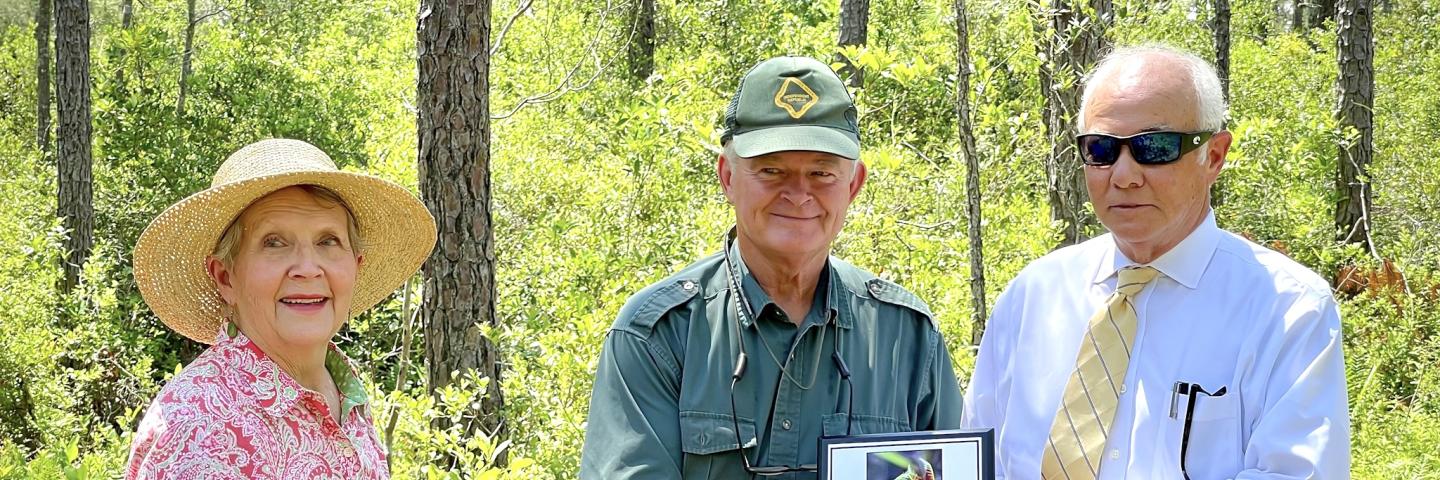Rare Venus Flytrap Has Brighter Future Because of Easements

NRCS partners with group to protect a very rare species native only to the Carolinas.
By Michael Mascari, Public Affairs Officer, michael.mascari@usda.gov
The muggy, buggy terrain in one area of Horry County can be hostile to those working the land, but for one resident, the conditions are well-suited.
The Venus Flytrap, often seen only in movies, thrives on the edges of elliptical wetlands known as Carolina bays. The plant exists in the wild in only a few places in the world, all of which are located within a 60-mile radius of Wilmington, North Carolina. The Venus Flytrap (Dionaea muscipula) is Federally-listed as an at-risk species and is under status review by the US Fish and Wildlife Service (USFWS) for potential listing as a Threatened or Endangered Species.
McDowell Preserve, once primarily grazing land, is one of the few remaining parcels of land in South Carolina with native populations. NRCS Wildlife Biologist Sudie Thomas has been instrumental in research and protection by working with landowners and a group of conservation partners. The partners include South Carolina Department of Natural Resources Heritage Program, USFWS Partners for Fish and Wildlife Program, the Long-leaf Alliance, the American Forest Foundation, and the Venus Flytrap Champions (VFC), a group of partners dedicated to the preservation of the unique plant.
“This area is extremely important to the future of the Venus Flytrap,” Thomas said. “It’s the second-largest protected population in South Carolina. McDowell Preserve provides ideal habitat for flytrap and numerous rare plants.”
The McDowell Preserve-named for the previous land-owner Harry McDowell-was identified as excellent wet-land habitat. McDowell started the easement process around 2001, but donated the acreage to Horry County Conservation Foundation (HCCF), an organization formed to maintain habitat for native vegetation and wildlife.
Other known species include several rare and tracked plants, such as Carolina-lead plant, false indigo, pixie moss, one-flower honeycomb head, and Pickering’s dawn flower. Animals who call the preserve home include black bears, reptiles, amphibians, and songbirds including Bachman’s sparrow.
NRCS worked with HCCF through a program now known as a Wetland Reserve Easement through the Agricultural Conservation Easement Program. The agency designed these easements to conserve wetlands with technical and financial assistance. The original program’s main focus was to restore, protect and enhance wetlands for optimum wildlife habitat
The VFC recently awarded HCCF board members Sam Ward and Kemp Floyd with a plaque for its flytrap preservation efforts in May.
Julie Moore, VFC President, presented HCCF board members Sam Ward and Kemp Floyd a plaque honoring their efforts in partnership with several government and non-profit agencies to ensure the future survival—and a chance to stave off Threatened and Endangered Species status—for the carnivorous plant.
“These steps we’ve taken are necessary because we don’t want this plant to go extinct,” Sam Ward said. “By partnering with NRCS and taking out this easement, it allows us to save this piece of property in perpetuity. I hope to soon take my grandchildren out her to see this rare species in its natural habitat.”

